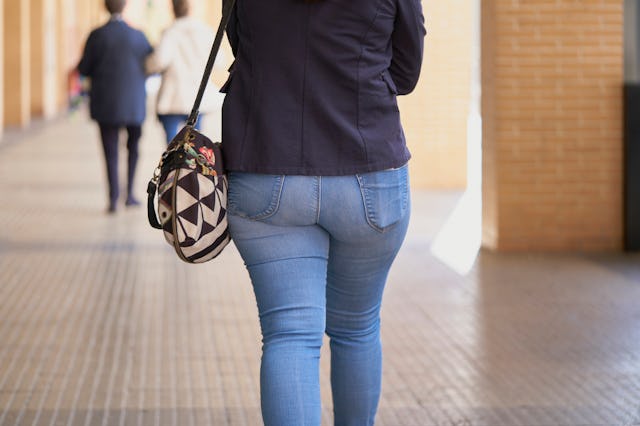How To Prevent “Chub Rub” From Wrecking Your Favorite Jeans
It's normal and can happen to all of us, but holy moly, it is annoying AF.

Among the many annoying parts of having a body is chub rub, which is really just a cutesy name for the type of chafing that happens when the skin on your legs rubs together as you move.
While there are plenty of ways to eliminate the physical discomfort that comes along with chub rub, it’s worth pointing out that all body types experience chafing on the thighs and other parts of the body, and there is absolutely nothing wrong with you if you deal with chafing. And even if you’ve got the best products to help ease the pain, you might still experience fabric breakdown, particularly on your go-to pair of pants or denim.
So, what do you do when you notice the telltale signs of wear in the crotch or thighs of your favorite pair of jeans? And can you prevent it from happening in the first place? A fabric pro and a laundry scientist are here to, ahem, break it all down for you.
Why Why Why
Unfortunately, fabric breakdown is both expected and by design, according to both pros. “I think the important thing to remember is that no garment will live forever,” says Kristen McCoy, the owner of RETHINK Tailoring & Sewing Lounge. “We ideally want that garment to be able to break down in the landfills. Friction is a main culprit, especially when it comes to thunder thighs (as I call my own).”
“Wearing out happens when high forces and mechanical friction cause stretching and abrasion, leading to damage and compromising the structure of the fabric,” adds Sammy Wang, MSE, Downy Senior Scientist. “In the inner thigh area, these high friction forces cause fabric-on-fabric rubbing, leading to abrasion, fuzzing, pilling, and loose ends (or fibrils) to form and worsen over time.”
Curious why it happens more often with jeans than any other pants in your closet? "It is especially common in cotton-based fabrics like denim because cotton's structure has more fibrils to begin with and because jeans experience a lot of mechanical forces during wear," says Wang. "While there are some types of fabrics that can resist mechanical abrasion better (typically synthetic, extruded fibers like polyester or nylon that don't have loose ends or fibrils), jeans are especially prone to wearing out in the inner thighs."
Adds McCoy, "Once spandex and elastane were introduced into jeans, that process of deconstruction sped up, because these fibers are not as stable as cotton. We likely have all seen an old swimsuit or a vintage skirt where you stretch the elastic and hear the dreaded crunch. Elastic and stretchy fibers are often the first things to self-destruct. They provide a purpose, especially when it comes to a flexible and comfortable fit, but they do not contain the same longevity that 100% cotton provides, and stretch jeans are not immune to this problem."
Is it preventable?
Denim destruction isn't entirely preventable, but you can help prolong the integrity of your fave pants, which likely means laundering them far less frequently. "First off, we wash our clothes way too often," says McCoy. "I know that in American culture, it feels icky to not wash your clothes after every wear, but the reality is that it's hard on our garments and the planet."
Suggests Wang, "Always check the care labels on garments and follow the care instructions to keep your jeans in their best condition." Both pros recommend washing with cold water and air-drying whenever possible, as heat from the dryer can accelerate fabric breakdown.
“If you start to feel your jeans wearing out in the thighs, you can pre-empt a tear by using an iron-on or sew-on patch on the inside to reinforce the area that’s thinning,” says Wang. Other signs of wear-out include puckering or thinning, which can be more easily seen if you hold the fabric up to the light, says McCoy. “Repairing it as early as possible makes it so much easier,” she notes.
“Many tailors or alteration services will also provide patching services if you prefer to leave the sewing and patching to the professionals,” adds Wang.
That New-New
If your favorite pair is too far gone and you need to shop for new denim, what should you look for in terms of longevity? “Some denim fabrics are blended with polyester, spandex, or lycra to provide stretch and comfort, while some are 100% cotton,” explains Wang. “Some even have special finishes to help with durability. While it’s difficult to create a completely rub-resistant denim, in general, heavier weight denims tend to be more abrasion-resistant.”
McCoy notes that denim made of 100% cotton is your best bet, depending on where you buy from. “In fast fashion, fabric quality keeps going down,” she says. “Finding brands that take pride in their material sourcing can also be helpful.” Both pros mention that denim with a distressed/vintage look or “soft-touch” might look and feel great, but “that process is made to mimic the natural process that happens when you wear your jeans over time,” says McCoy. “So while they look cool, it comes to you with years already taken off your jeans.”
The TL;DR
"Please remember that there is nothing wrong with you" if chub rub conquers your denim, says McCoy. "Clothing just eventually wears out, and that's OK." That said, "If you buy jeans you love and are willing to repair when they wear out, that is key." If it happens with every pair of jeans you own, she recommends adding reinforcements to the inside of new jeans, which will extend their longevity before they even begin wearing out.